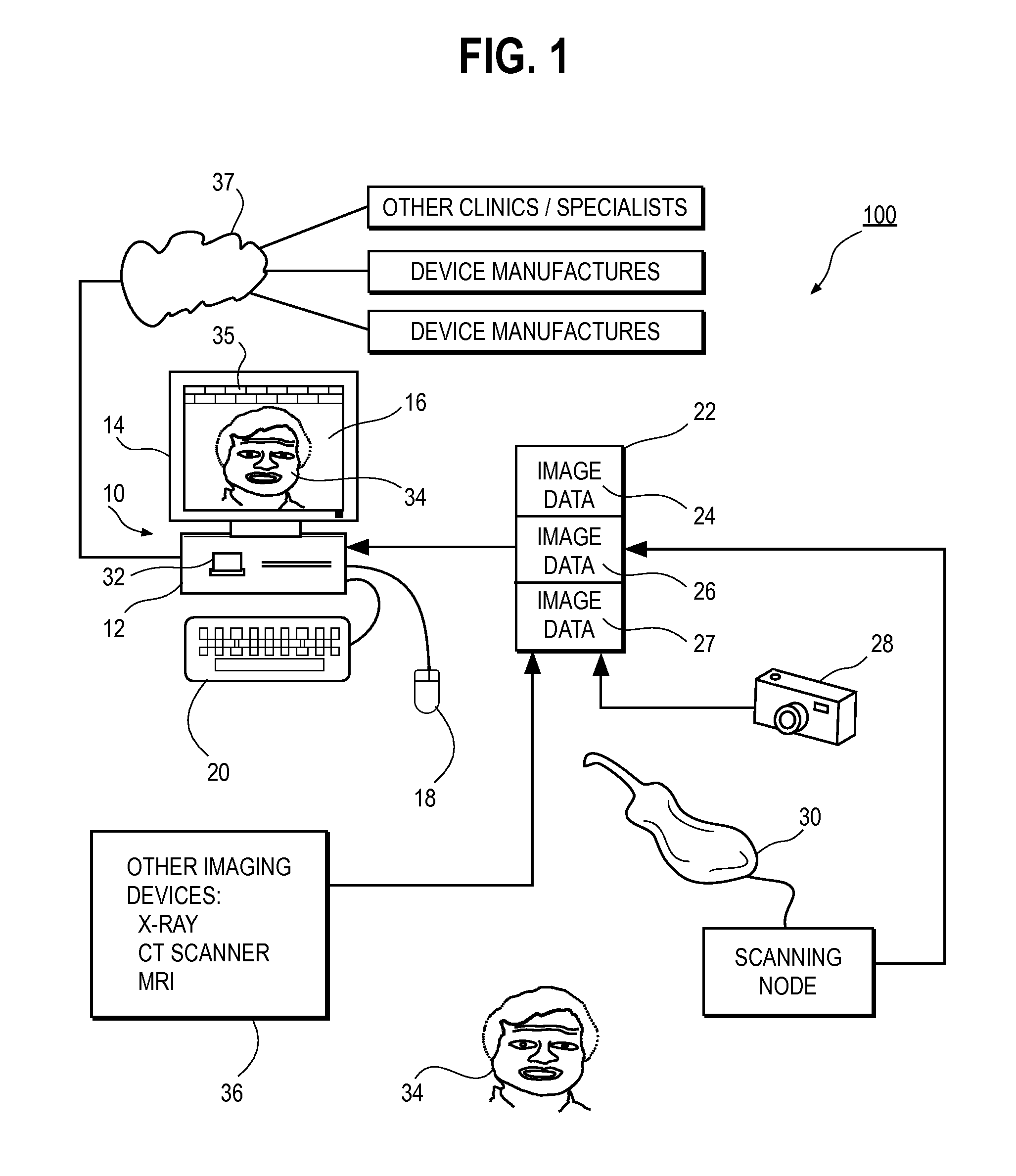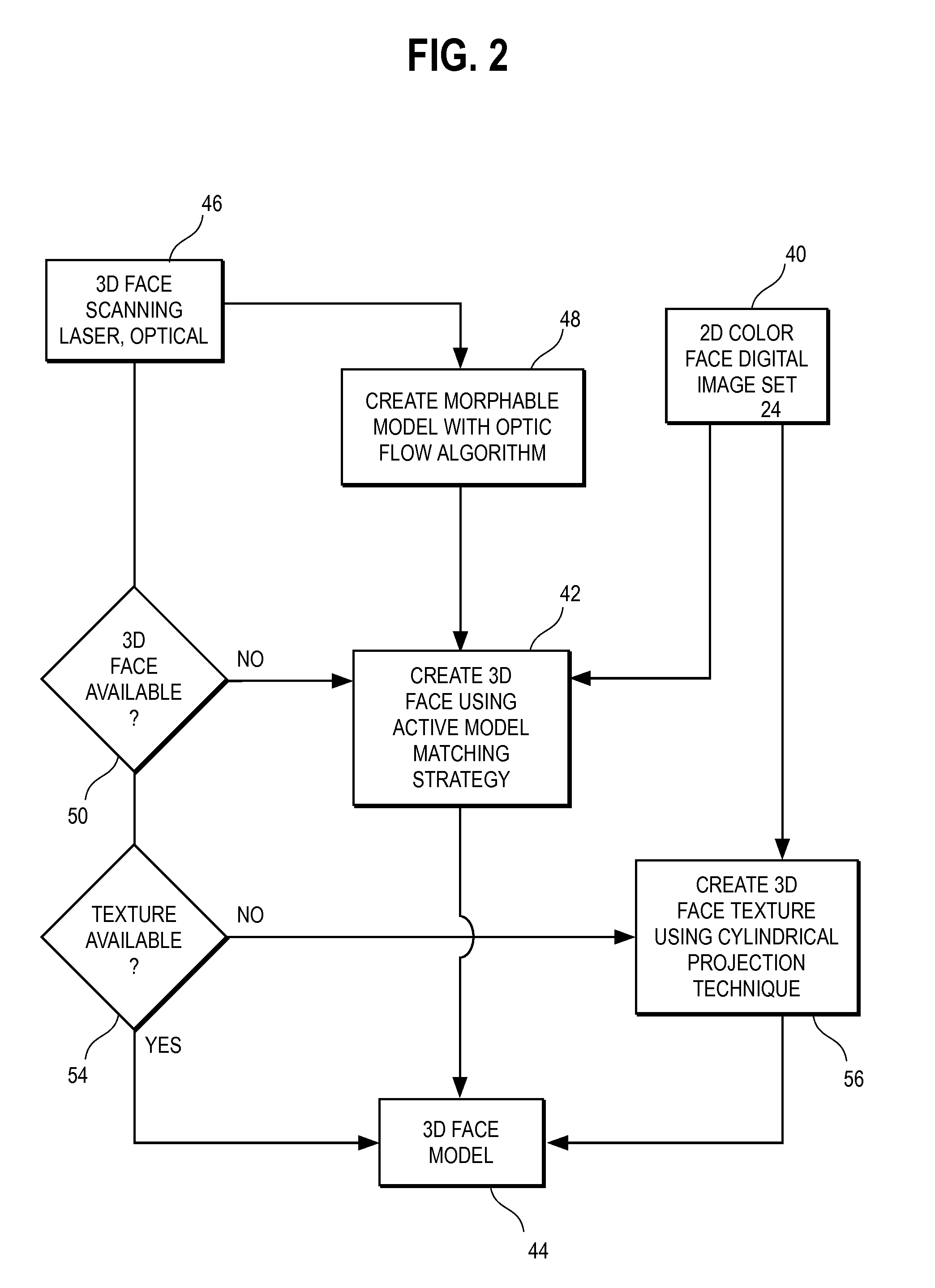[0022]The method and workstation further involves using the
graphical user interface to a) evaluate space between the virtual teeth and arch length requirements, b) evaluate the effect of various constraints on the arch length, and design a desired
arch form for the patient, and c) move virtual teeth in a three-dimensional model of the patient from an initial orientation relative to the desired
arch form,
occlusal plane, midline,
tooth position, reference tooth so as to arrive at a proposed tooth arrangement for treatment of the patient. Furthermore, the interdependency of the constraints can be evaluated. Preferably, the
user interface provides tools that enable the practitioner to perform the task of
space management between teeth in each arch to assure that there would be adequate space to accommodate the contemplated teeth alignment.
Space management is done with respect to mandible and maxilla, both at the intra arch and inter arch level.
[0025]In another embodiment of the invention, assignment of values to variables, such as markings, tooth alignment, and
space allocation, is integrated in a manner such that the most current selection or value for each such variable is retained by the workstation and made available at any other step in the treatment
planning process besides the one where the specific value was originally assigned. For example, the midline marking done first on the 2D photos of the patient will be shown in the same position on appropriate 3D model of the patient's teeth used in teeth alignment and
space management. The converse is also true, i.e., markings on a 3D
virtual patient model will be available in 2D images of the same patient. An aspect of this invention is that a variable (such as the location of the midline in a 2D photograph) may be assigned a certain value at one step, and be modified at another step. Such integration is realized through proper scaling and synchronization of patient's characteristics and features prevalent through 2D photographs and 2D and 3D images and models. A major benefit of this invention is that throughout the treatment
planning process patient's biological interdependence between
soft tissue, skeletal, and dental disposition is maintained and resulting constraints applied in a consistent manner such that unfeasible
treatment options are filtered out. In turn, the benefit results in producing efficient and cost
effective treatment plans. Additionally it is possible to stage treatment and compare progress against the staged treatment. The
treatment plan can be actuated or initiated at any point in treatment to respond to any change that may occur.
[0027]In yet another embodiment of the invention, the unified work
station facilitates rapid selection of treatment plan driven by templates. The practitioner provides specific values or ranges of values for the
treatment parameters, such as for midline, maxilla and mandible levels and cant for aesthetic occlusal plane, various positions for upper and lower occlusal planes, reference tooth,
arch form and alignment parameters for teeth, and
space requirements, etc. for patient. The unified workstation, using computer instructions based tools, searches a clinical benchmarking
knowledge base consisting of reference treatment plans for a large number of individual patients for a reference treatment plan. The search essentially cross-references using parameter values (e.g., archform shape, diagnosis, appliance type, etc.) and successful treatments and finds the most suitable reference treatment, if one is available in the
knowledge base. In one possible embodiment, the workstation enables the practitioner to create and update such
knowledge base through a self-learning process aided by computer instruction tools resident in the unified workstation.
[0029]In yet another embodiment of the invention, the unified workstation provides
computer software instruction in the form of
user interface tools that aid in treatment planning in a number of ways. For example, original teeth models can be superimposed on the aligned teeth model, where original teeth positions are shown in one color and the aligned teeth in another color, to visualize the effect of teeth disposition. Constraints (e.g., midline, occlusal plane, etc.) can be defined both in 2D and 3D images. They are interchangeable and changes made in 3D are applied automatically in 2D and vice versa. Occlusal planes can be superimposed on 3D teeth model to display malocclusion of the original teeth, and the combination further superimposed on the model of the properly aligned teeth to see the improvement. The midline can be superimposed on 3D teeth models. Three-dimensional
gingival tissue, obtained from an intra-oral scan, can be superimposed on 3D teeth model at any stage in the treatment planning process. In a representative embodiment,
color coding is invoked to show different aspects of the display. A grid can be superimposed on 3D teeth model to aid in visualizing certain measurements.
Animation light can be thrown on 3D teeth model, and teeth can be shaded based upon their location with respect to the animated
light source so as to aid in viewing otherwise difficult to see detailed teeth features. This can also be done while 3D teeth model is rotated to give views from different angles.
 Login to View More
Login to View More  Login to View More
Login to View More 


